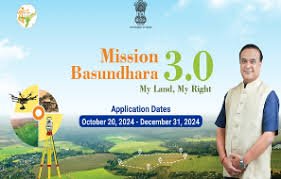Mission Basundhara 3.0: Assam’s Push for Indigenous Land Rights
Introduction to Mission Basundhara 3.0
Assam’s government has launched Mission Basundhara 3.0, an initiative aimed at safeguarding indigenous land rights and enhancing land governance. This mission marks a significant step in the ongoing efforts to empower indigenous communities by ensuring their rightful ownership of land. The program is designed to streamline the process of land records management and facilitate easier access to land-related services, promoting transparency and accountability within the system.
Objectives of Mission Basundhara 3.0
The primary objective of Mission Basundhara 3.0 is to provide legal recognition to land ownership for indigenous communities, which is crucial for their social and economic development. By digitizing land records and creating a robust land management system, the Assam government aims to eliminate land disputes and illegal encroachments. This mission will not only help secure land rights for indigenous people but also promote sustainable development and conservation of natural resources.
Implementation Strategies
The government plans to implement Mission Basundhara 3.0 through various strategies, including the use of technology to enhance land record management. The initiative will involve extensive training programs for officials and community leaders to ensure effective execution. Additionally, the government intends to involve local communities in decision-making processes related to land governance, fostering a sense of ownership and responsibility among them.
Expected Outcomes
With the launch of Mission Basundhara 3.0, Assam anticipates significant improvements in land management, enhanced land rights for indigenous populations, and reduced conflicts over land ownership. The initiative is expected to create a more equitable and just system that recognizes and respects the rights of indigenous communities. Ultimately, this mission aims to contribute to the socio-economic upliftment of these communities, ensuring their sustainable development and well-being.

Why This News is Important
Empowerment of Indigenous Communities
Mission Basundhara 3.0 is crucial for the empowerment of indigenous communities in Assam, as it directly addresses their historical grievances regarding land ownership. By securing land rights, the government can help uplift these communities, providing them with opportunities for economic development and stability.
Promotion of Sustainable Development
This initiative is not just about legal recognition; it also focuses on sustainable development. By encouraging responsible land management and conservation, Mission Basundhara 3.0 aligns with global sustainability goals, making it a progressive step towards ecological balance.
Reducing Land Conflicts
Land disputes have long plagued Assam, often leading to violence and social unrest. The digitization of land records under this mission is expected to minimize conflicts and ensure that land ownership is clearly defined, fostering peace and stability within communities.
Enhancing Government Transparency
By streamlining land governance and making processes more accessible, the Assam government is promoting transparency and accountability. This initiative serves as a model for other states, demonstrating how technology can improve governance.
Encouraging Local Participation
Mission Basundhara 3.0 emphasizes the involvement of local communities in land governance. This participatory approach ensures that the voices of indigenous people are heard, leading to more effective and culturally sensitive policies.
Historical Context
Background of Land Rights in Assam
The struggle for land rights among indigenous communities in Assam dates back several decades. Historical policies often marginalized these communities, leading to illegal encroachments and loss of land. The Assam Accord of 1985 aimed to address some of these issues, but challenges remained.
Previous Initiatives
Before Mission Basundhara 3.0, the Assam government launched earlier phases of the initiative, focusing on land record digitization and community engagement. However, these efforts often fell short due to bureaucratic inefficiencies and lack of public awareness. The introduction of Mission Basundhara 3.0 aims to build on past experiences, learning from successes and failures to create a more effective framework for land governance.
Key Takeaways from Mission Basundhara 3.0
| S.No | Key Takeaway |
|---|---|
| 1 | Mission Basundhara 3.0 aims to secure indigenous land rights in Assam. |
| 2 | The initiative focuses on digitizing land records to improve land governance. |
| 3 | Local communities will participate actively in decision-making processes. |
| 4 | The mission seeks to reduce land conflicts and promote sustainable development. |
| 5 | Enhanced transparency and accountability in land management are key objectives. |
Important FAQs for Students from this News
1. What is Mission Basundhara 3.0?
Mission Basundhara 3.0 is an initiative launched by the Assam government aimed at securing indigenous land rights and improving land governance through digitization and community involvement.
2. Why is securing indigenous land rights important?
Securing indigenous land rights is crucial for empowering communities, promoting sustainable development, reducing land disputes, and ensuring that their cultural and historical connections to the land are respected.
3. How will Mission Basundhara 3.0 reduce land conflicts?
The mission aims to reduce land conflicts by digitizing land records, which clarifies ownership and reduces the chances of illegal encroachments and disputes over land ownership.
4. What role do local communities play in Mission Basundhara 3.0?
Local communities will actively participate in the decision-making processes related to land governance, ensuring that their needs and perspectives are taken into account.
5. What are the expected outcomes of this initiative?
Expected outcomes include enhanced land rights for indigenous populations, improved land management systems, reduced conflicts over land ownership, and overall socio-economic upliftment of indigenous communities.
Some Important Current Affairs Links


















 Exciting News!
Exciting News!  Join Our Telegram Channel Now!
Join Our Telegram Channel Now!
 Join our Telegram channel for a thrilling adventure into the world of daily current affairs.
Join our Telegram channel for a thrilling adventure into the world of daily current affairs. 
 Don’t miss out on the latest updates and insights! Click to join now and be part of the knowledge revolution!
Don’t miss out on the latest updates and insights! Click to join now and be part of the knowledge revolution! 
